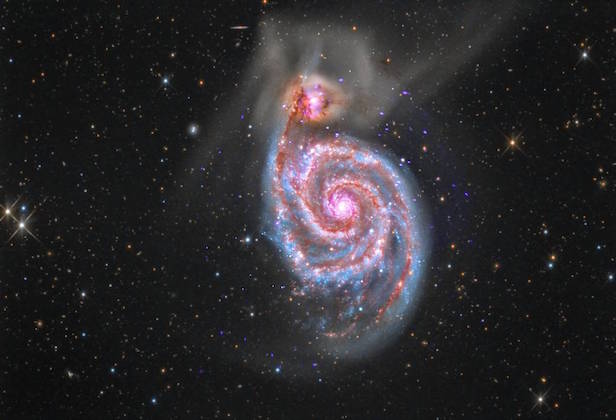Supermassive black holes ‘hide’ when galaxies merge
As galaxies prepare to collide, their central black holes become concealed with gas and dust

The active galactic nuclei in merging galaxies are enclosed in a ball of gas and dust. Image credit: NASA/Aurore Simonnet, Sonoma State University
What happens to supermassive black holes when their galaxies collide has been uncovered with surprising results. Using NASA’s NuSTAR telescope, astronomers have discovered that while these exotic, high-gravity objects are in fact turned into active galactic nuclei (AGN), compact galactic regions that have a higher-than-normal luminosity, they are in fact hidden away by enormous amounts of gas and dust.
Black holes should not be thought as mysterious entities that devour worlds, instead they should be considered as stars we cannot see. There is an abundance of stars, gas and dust surrounding a black hole, that’s usually in orbit around it, until there is a disruption, which then causes it to fall into the black hole’s event horizon, also known the point of no return.
A major disruption that can cause this is the merging of two galaxies, when galaxies merge; the gravity of the secondary galaxy interacts with the material orbiting the host galaxies centre. This causes the material orbiting the black hole to decrease in momentum and begin falling into the black hole.

The Whirlpool Galaxy’s AGN emits X-ray radiation as it interacts with NGC 5195 in the constellation of Canes Venatici. Image credit: X-ray: NASA/CXC/SAO; Optical: Detlef Hartmann; Infrared: NASA/JPL-Caltech
As the black hole devours more material and becomes more powerful, it will release extremely high-energy radiation, primarily in the form of X-rays, eventually becoming a highly luminous AGN. “The further along the merger is, the more enshrouded the AGN will be,” explains Claudio Ricci, lead scientist of the study, which involved scrutiny of 52 galactic nuclei. “Galaxies that are far along in the merging process are completely covered in a cocoon of gas and dust.”
It is this high-energy X-ray emission that is observed by the extremely sensitive NuSTAR telescope, this determines how much how much light has been able to escape his gaseous envelope. This data is then compared with low-energy X-ray data, already collected by NASA’s Swift and Chandra and ESA’s XMM-Newton observatories. If there is high-energy X-ray emissions detected but not low-energy X-ray, then that is a clear sign the AGN is concealed.
This research is key to understand how black holes at the galactic nucleus react with their host galaxy, particularly in the case of galaxy mergers.
Keep up to date with the latest space news in All About Space – available every month for just £4.99. Alternatively you can subscribe here for a fraction of the price!




